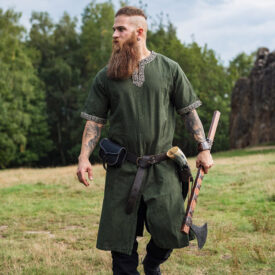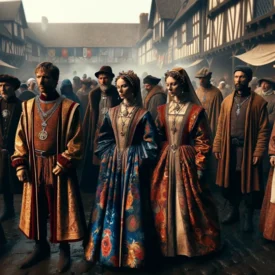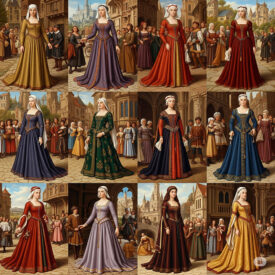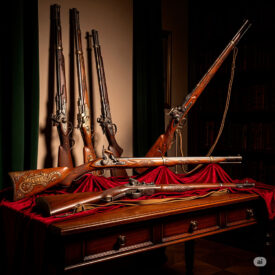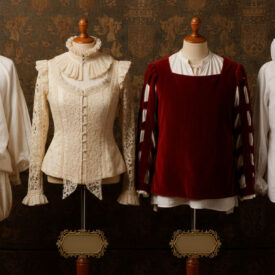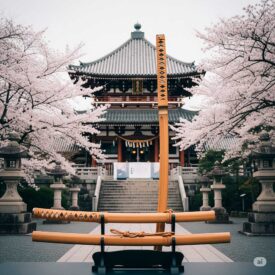Welcome, lovers of history and medieval fashion! In this post, we embark on a fascinating journey through time to explore beautiful medieval buckles that can completely transform your period belt, giving it a touch of authenticity, elegance, and historical depth. Imagine for a moment a world where every detail of your attire spoke of who you were, your position, and your story. In the Middle Ages, buckles were not just accessories for fastening a belt; they were true emblems of power, status, and art, silently narrating the lives and customs of their wearers.
From the simplest clasps, forged with the sturdiness needed for everyday use, to the most intricate works of goldsmiths adorned with gems and enamels, these pieces open a fascinating window into the lives and societies of the past. They not only served a practical function of adjusting the belt, but were also unmistakable symbols of social status and a reflection of personal style. So if you want to look like a true medieval knight or lady, imbued with the essence of those times, you can’t overlook the importance of a medieval buckle on your belt. Join us on this journey through time to discover the richness of period belt buckles from every angle, unveiling their secrets and their enduring charm.
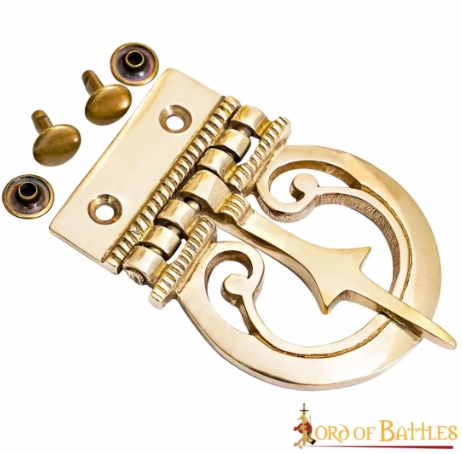
A Historical Journey: The Evolution of Buckles Through the Ages
The history of buckles is as ancient as civilization itself, with origins dating back to the Bronze Age. Long before the Middle Ages, in ancient Greece and Rome, “fibulae” already existed—brooches that, aside from their practical function of fastening tunics and cloaks, were lavishly adorned to reflect social status and wealth. These early forms laid the groundwork for the evolution of buckles as objects of utility and distinction.
The Middle Ages: From Utility to Symbolism and Artistry
During the Middle Ages, buckles underwent a remarkable transformation, evolving from mere fasteners to items laden with deep cultural and artistic meaning. At first, designs were relatively simple, reflecting a mostly functional need. But with advances in metallurgy and the florescence of craftsmanship, they became increasingly sophisticated, turning into true jewels that adorned the waists of both men and women.
The Roman “Cingula Militiae”: Forerunners of Medieval Distinction
Even before the core of the Middle Ages, during the Late Roman Empire, the cingulum (Roman military belt) was much more than a mere accessory. It was an official insignia of rank and dignity, not just for soldiers who defended the empire’s vast borders, but also for civil officials who managed the state. These late Roman belt adornments, often with elaborate decorated metal plates, have been found in the Iberian Peninsula, suggesting the presence of non-local troops, possibly Germanic, and the influence of Roman traditions in the dress of what would later become medieval Europe.
Regional and Chronological Diversity: A Mosaic of Styles
Buckle styles and designs varied greatly depending on region and era throughout the broad medieval period. This diversity testifies to each area’s different cultures, influences, and available resources:
- Early Medieval Buckles (5th-10th centuries): Characterized by robustness and practicality. Designs tended to be more straightforward, with stylized geometric or zoomorphic patterns that echoed the aesthetics of Germanic and barbarian cultures that settled Europe after Rome’s fall.
- Viking Buckles: Stood out for their interwoven animal motifs—often dragons, serpents, or mythical beasts—and Nordic symbols. These buckles were not only functional but also imbued with rich Viking mythology and decorative art.
- High Middle Ages (11th-13th centuries): With the resurgence of stability and trade, buckles became more refined. They adopted classic “D” or oval shapes and the ornamentation became more intricate, including detailed engravings and inset semi-precious stones, reflecting increased sophistication in courtly and urban life.
- Late Middle Ages (14th-15th centuries): This was the height of buckle craftsmanship. Gothic buckles incorporated intricate architectural elements such as pointed arches and openwork tracery, and even vibrant enamelling. New shapes emerged, like the double-frame buckle, allowing for even more complex designs. Northern European Gothic buckles were noted for their elegance and detail, while Celtic buckles continued to show their intertwined and animal patterns, adapting to new trends without losing their identity.
Archaeological Finds: Windows to the Past
Archaeological discoveries have provided invaluable insight into the fashion and craftsmanship of the time. Sites like Sutton Hoo in England, with its famous Anglo-Saxon treasure, have revealed the diversity of styles and materials used for buckles and other ornaments. Preserving and studying these pieces is essential for historical research, as every buckle is a tangible fragment of medieval life, an object connecting the present to the past.
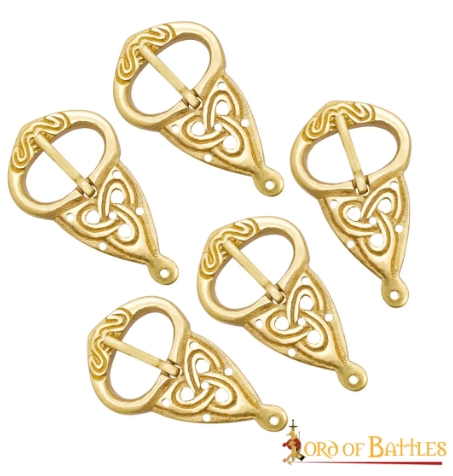
What Are Medieval Buckles and What Are Their Key Features?
Medieval buckles are essentially metal pieces designed to secure and adjust a belt around the waist or other parts of the body. However, their significance goes well beyond mere functionality. These pieces were often crafted from a variety of materials, from the humblest to the most luxurious—bronze, brass, iron, silver, and even gold. Their surface was a canvas for artistic expression, decorated with intricate engravings, delicate inlays of precious or semi-precious stones, vibrant enamels, or carved motifs depicting everything from daily life scenes to heraldic or religious symbols.
Medieval buckles were considered true works of art, and their design and craftsmanship reflected not only the fashion and style of the era in which they were made, but also the beliefs, values, and social hierarchy of medieval society. The quality of materials, the complexity of design, and the mastery of execution were direct indicators of the wearer’s status and wealth. Each buckle told a story—a fragment of its owner’s identity—distinguishing itself far beyond its practical purpose to become a symbol of prestige and good taste.
Types of Medieval Buckles: A Range of Designs and Meanings
The diversity of medieval buckles is astonishing, each with a unique style and design suited to the trends of the time, region, and purpose. Some of the most common and representative types include:
- Floral-motif belt buckles: These frequently showcased delicate engravings of flowers, leaves, or branches, inspired by nature and botanical iconography. Often associated with elegance and femininity, they were also popular in masculine courtly dress. Their look was generally more refined and delicate, lending an aura of sophistication.
- Geometric-motif belt buckles: These pieces featured designs based on geometric shapes like circles, squares, diamonds, triangles, or interwoven patterns. They created a striking and sophisticated visual effect, often with symmetry that echoed order and harmony. They were common across various cultures and periods, from early medieval to Gothic buckles.
- Animal-motif belt buckles: These buckles bore engravings of animals, both real and mythical—lions, dragons, eagles, griffins, or serpents. Each animal symbolized different qualities: the lion, strength and nobility; the dragon, power and mystery; the eagle, authority and vision. They were popular among the nobility and warriors, symbolizing strength, power, bravery, or even heraldic affiliation.
- “D-shaped” or Oval Buckles: These classic shapes were very common, especially from the High Middle Ages onward. Their simplicity permitted great versatility in ornamentation, from simple engravings to complex inlays.
- Double-frame buckles: Emerging in the Late Middle Ages, these allowed for increased structural and decorative complexity. They were ideal for wider belts and offered more space for intricate designs.
- Gothic Buckles with Architectural Elements: Inspired by the grandeur of Gothic cathedrals, these buckles included pointed arches, openwork tracery, and rosettes, often with enamels that enhanced their details—true architectural miniatures.
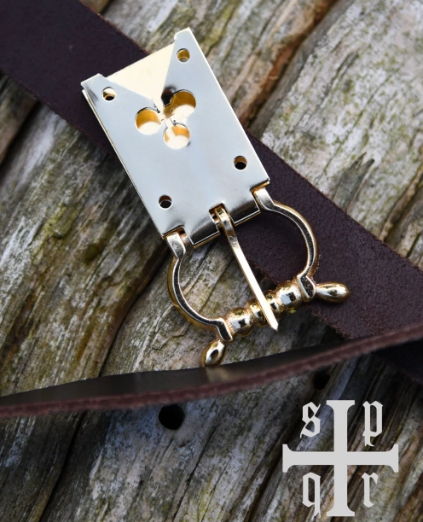
Technical Aspects: Materials and Crafting of Medieval Buckles
The creation of a medieval buckle was a true art—an intricate process combining the artisan’s skill with available resources. The materials and techniques determined not just the durability and function, but also the wearer’s status, region of origin, and the piece’s era.
Primary Metals and Other Materials
The choice of metal was crucial and reflected both availability and purchasing power:
- Bronze: An alloy of copper and tin, bronze was extremely common from the early Middle Ages. It is corrosion-resistant, relatively easy to work with, and offers a good base for engraving and enameling. Its durability made it ideal for everyday buckles.
- Brass: An alloy of copper and zinc, brass was valued for its golden hue—resembling gold at first glance—and its malleability. It was much used for more ornate buckles, particularly from the Late Middle Ages onward, when casting and decorative techniques became more refined.
- Iron: Affordable and strong, iron was the material of choice for everyday buckles, especially for peasants, artisans, and lower-ranked soldiers. While prone to rust if untreated, its resistance made it ideal for work and combat.
- Silver and Gold: These precious metals were reserved for the nobility, royalty, and high clergy—symbols of status and wealth. Silver and gold buckles were often intricately worked, with gem inlays and enamels, making them genuine jewels.
Beyond metals, the belts themselves also reflected status. The wealthy wore silk belts—luxurious imported material—often adorned with precious metal and stone fittings. Even “wide ribbons” were used, mainly silk for the nobility, although few survive today due to the fragility of organic material.
Craft Techniques: Medieval Mastery
Crafting buckles involved various metallurgical and decorative techniques, each requiring considerable skill:
- Casting: This technique enabled the production of complex designs and, to a degree, series production. Molten metal was poured into clay or stone molds to form detailed shapes, which were then polished and finished. This was ideal for pieces with raised ornamentation.
- Forging: For stronger, customized pieces, metal was heated and hammered. This required great strength and dexterity and allowed the blacksmith to shape and harden the metal—making buckles durable for daily or military use.
- Engraving: With the basic buckle shape ready, artisans used burins and chisels to carve intricate designs—either figurative (animals, scenes) or abstract (geometric patterns, inscriptions).
To further embellish these pieces, various decorative techniques were applied:
- Enameling: This involved applying finely ground colored glass to the metal’s surface and heating it at high temperature to create vibrant, long-lasting designs. Enameling could be cloisonné (with metal cells) or champlevé (with cavities carved in the metal).
- Gilding: To give the look of gold to less expensive metals, a thin gold layer was applied—either using a mercury amalgam (a risky but effective technique) or gold leaf.
- Gem Setting: Inlaying gems (rubies, sapphires, emeralds) or semi-precious stones (garnets, agates) added extraordinary value and beauty to buckles. Stones were either claw-set or inset directly into the metal.
Practical Use: Beyond Style and Display
Medieval buckles were indispensable in the daily life of all social classes, blending function and design masterfully. Their utility went far beyond aesthetics, serving as essential tools for personal organization and dress.
Everyday Use and Essential Functions
Belts and buckles played crucial roles in medieval life:
- Garment support: Their most obvious function was to adjust tunics, dresses, cloaks, and footwear—ensuring garments stayed in place and fit comfortably. This was especially important when clothing was typically looser.
- Transporting objects: Belts were true “tool belts” of the era. They were essential for carrying a wide variety of personal and work items, from artisan tools, knives, and daggers, to coin purses, sword sheaths, and even small books or rosaries. Buckles for weapons and armor needed to be particularly strong and functional to bear the weight and strain of combat, ensuring gear stayed secure at all times.
- Support for weapons and armor: For warriors, buckles and belts were crucial for distributing the weight of weapons and armor pieces—swords, daggers, chainmail—allowing for greater mobility and comfort on the battlefield.
Buckles vs. Hooks: Practical and Technical Differences
Though buckles are the most well-known and ubiquitous, belt hooks also played an important role, especially in military and work clothing—where speed and simplicity could be crucial. Here’s a comparison of their characteristics:
| Feature | Hook Advantages | Hook Disadvantages | Buckle Advantages | Buckle Disadvantages |
|---|---|---|---|---|
| Speed | Faster adjustment and release, ideal for situations that require speed. | Less precise adjustment; often only one or two fixed positions. | Greater security and closure stability, less likely to open by accident. | Slower adjustment process, as you have to thread the strap through the pin. |
| Safety | Less likely to catch on surroundings, making them useful for manual work. | Potentially less secure for heavy loads or abrupt movement. | Offer greater variety in decorative designs and intricate shapes. | Greater risk of catching on other objects or garments due to protrusion. |
| Weight & Design | Generally lighter and less conspicuous. | Limited options for ornate designs; more utilitarian. | Allow for finer adjustment thanks to multiple holes. | Tend to be heavier and bulkier, especially the more elaborate ones. |
How Was a Medieval Belt Worn? The Art of the “Medieval Knot”
Wearing a medieval belt often involved a special technique known as the “medieval knot,” which not only secured the belt but also added a distinct aesthetic touch. To determine the proper length of a medieval belt, you should measure your waist circumference and decide how much you want the end to hang once fastened (about 30 cm or more is ideal for the desired effect). Remember that the knot itself takes up approximately 30 extra cm of the belt’s strap. For example, for a 90 cm waist and a desired drop of 40 cm, the belt should measure around 160 cm (90 cm waist + 40 cm drop + 30 cm for the knot). This extra length allowed the belt’s end to dangle elegantly, often with a decorative tip, adding a touch of style and authenticity to the attire.
Caring for Historical Buckles: Preserving the Past
To maintain the beauty and functionality of these precious historical pieces, whether original or high-quality replicas, a proper care routine is crucial. Regular cleaning with a soft, dry cloth is essential to remove dust and surface grime. Avoid excessive humidity, as it can cause corrosion, especially in metals like iron. Use products specific to each type of metal (bronze, brass, silver) and always follow manufacturer instructions. For repairs or restoration of old pieces, always rely on professionals specialized in conserving historical metals and objects, who have the know-how and tools to handle these delicate treasures safely.
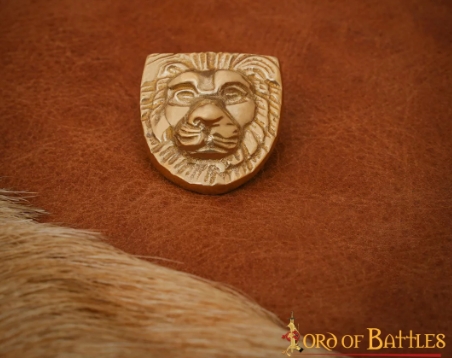
Social Meaning: A Symbol of Identity and Status
Medieval buckles were much more than simple fashion elements—they were powerful symbols revealing the wearer’s identity, social status, wealth, and even political or religious affiliations. They were a form of nonverbal communication in a society where distinctions were clear and clothing played a crucial role in self-affirmation.
Social Classes and Distinction Through Buckles
The gap between buckles among the social classes was vast and easily perceived:
- Nobility and Knights: Members of the elite showed off elaborate buckles, often of precious metals like gold and silver, lavishly adorned with gems, pearls, enamels, or heraldic shields of their families. These were ostentatious displays of rank, wealth, and power, and were often passed down as family heirlooms.
- Clergy: High clergy members also wore high-quality buckles, often with religious or ecclesiastical symbols, reflecting their spiritual authority and position within the Church hierarchy.
- Merchants and Well-off Bourgeois: As cities grew and the merchant class prospered, wealthy bourgeois also invested in good brass or bronze buckles, often with intricate designs that imitated those of the nobility, though without the opulence of precious metals.
- Peasants and Artisans: In contrast, peasants and artisans wore simpler buckles, usually of iron or bronze, reflecting their more modest status and their need for functionality over ostentation. These buckles were sturdy and made to withstand the rigors of daily labor.
Women and the Fashion of Buckles
Although often associated with male attire, women also used buckles as decorative elements on belts, sashes, shoes, and even headpieces, reflecting their wealth and social position. Female buckles tended to be smaller and more delicate in design, often featuring intricate filigree, small stone settings, and colorful enamels. These pieces complemented the elaborate dresses and tunics, adding a touch of grace and luxury.
Fashion’s Influence: Reflecting Cultural Change
The evolution of medieval fashion had a direct impact on buckle design. From the more functional and robust buckles of the early Middle Ages, which prioritized durability and simplicity, to the elaborate and luxurious pieces of the Gothic and Renaissance periods, which reflected increasing sophistication and a growing emphasis on personal adornment. Each change in clothing silhouette, textile materials, or aesthetic trends resulted in new shapes and styles for buckles, making them a microcosm of fashion evolution.
Presence in Art and Literature: The Cultural Legacy of Buckles
Buckles didn’t just exist in the tangible reality of medieval dress—their importance and symbolism echoed deeply in the culture of the time, as seen in works of art and literary texts.
- In literature: Buckles often symbolized abstract concepts such as loyalty (especially in the context of oaths or alliances), chivalry (as an essential part of a knight’s equipment), or authority (as a sign of rank). In epic poems, chivalric romances, or historical chronicles, the description of a buckle could be a significant detail adding depth to the character or narrative—indicating status, wealth, or even morality.
- In medieval art: Illuminated manuscripts, cathedral sculptures, tapestries, and frescoes frequently depict figures with their belts and buckles in detail. These artistic representations highlight the importance of buckles in fashion and society, and also serve as valuable sources for historians and archaeologists, helping reconstruct period styles and uses in detail.
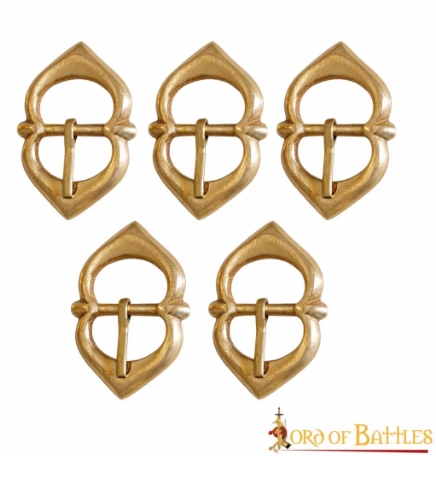
How to Choose the Perfect Medieval Buckle? Buying and Usage Advice
When choosing a medieval buckle for your period belt, there are several key aspects to help you find the piece that best suits your needs and the style you wish to project. Consider the material, the design, and the overall look that will best complement your medieval outfit. Here are some practical tips for finding the perfect medieval buckle, tailored to different user profiles:
- Choose a quality material: Opt for buckles made of durable materials that will stand the test of time. For general use and a good balance of quality and price, bronze and brass are excellent choices—they are sturdy and allow for detailed designs. If you’re looking for an authentic replica or a more luxurious piece, silver is a magnificent choice. Avoid low-quality materials that may rust or deteriorate quickly, especially if you plan to use your belt frequently.
- Pick a design that fits your style and the period you represent:
- For beginners or casual adventurers: If you’re starting out in historical reenactment or just looking for a medieval touch for special events, a buckle with simple geometric or floral motifs in brass or bronze is a versatile and elegant option that will match most outfits.
- For enthusiasts or advanced reenactors: If you want a bolder look or wish to portray a specific period, a buckle with animal motifs (such as lions or dragons) or intricate Gothic designs may be ideal. Research the historical period you’re interested in to ensure your buckle design is accurate.
- For experts or collectors: Consider buckles with advanced decorative techniques like enameling or stone inlays, or exact replicas of archaeological finds. These pieces are not only beautiful but are also a testament to medieval craftsmanship.
- Match your buckle with your outfit: Be sure that your chosen buckle harmonizes with the rest of your medieval look. Take into account the color and style of your belt, cloak, boots, and any other accessories. A cohesive, balanced appearance is key for convincing authenticity. For example, a sturdy iron buckle could be perfect for a peasant or warrior outfit, while a delicate brass buckle with floral details would complement a lady’s dress.
- Consider the purpose: Is it for a historical reenactment, a medieval festival, LARP, or just a fashion accessory? If for combat or heavy use, functionality and sturdiness should be your priorities. If for display or a more formal outfit, detail and looks will be more important.
The Timeless Fascination with Period Buckles: Connecting with the Past
Medieval belt buckles continue to captivate historians, reenactors, LARP enthusiasts, and anyone with a genuine interest in the past. Their appeal lies in the perfect blend of function and aesthetics, transporting us directly to a bygone era full of craftsmanship, symbolism, and rich history. Every curve, engraving, and material used in these pieces speaks of the hands that made them and the lives they touched.
Today there is a thriving market for high-quality replicas that allows enthusiasts to connect with the past in a tangible, personal way. These replicas are not only fashion accessories, but also educational tools that help us better understand medieval life and customs. Exploring this fascinating world of medieval buckles is a true journey through time—each piece has a unique story and helps bring your own vision of the past to life, whether for a reenactment, a costume, or simply to add a historical touch to your personal style.
Medieval buckles are unique, elegant pieces that can give your period belt a matchless touch of authenticity and style. If you’re passionate about medieval history and fashion, you can’t go without a medieval buckle in your collection. So don’t wait any longer: find the perfect medieval buckle for you and start writing your own story with every detail of your attire. Discover a wide range of medieval and historical buckles, belts, and other beautiful medieval clothing accessories in our online shop. Immerse yourself in the past and complete your outfit with the authenticity that only a carefully selected piece can offer.
SEE MEDIEVAL AND PERIOD BELT BUCKLES
